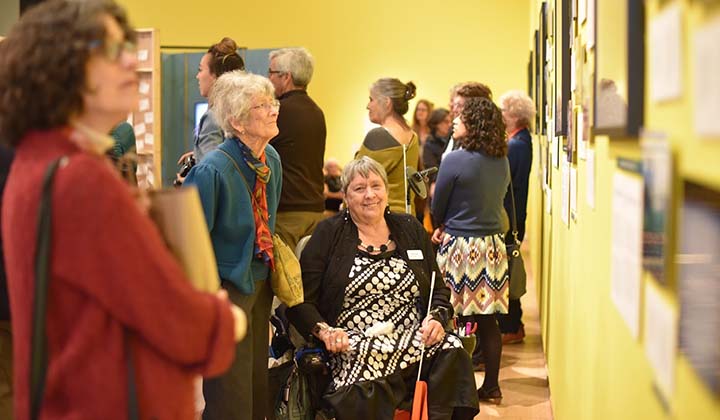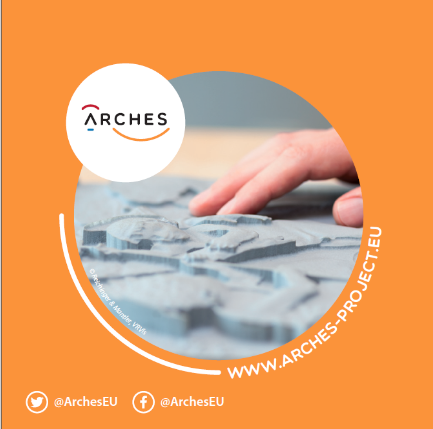The project ARCHES will organize a series of workshops with the objective to reach museum professionals in Europe and around the world. The first Workshop will take place in Spain on 13.6.2019, Lázaro Galdiano Museum, Madrid
Germany: fall of 2019, Bundeskunsthalle, Bonn
France, fall of 2019: Musée d’arts de Nantes
Italy, fall of 2019: TBC
Croatia and Slovenia, fall of 2019: TBC
These workshops will be accompanied by a 80 page handbook, published in three languages (German, English and Spanish) which will be both printed and distributed as a PDF and plain text through the ARCHES website.
First workshop: Towards a Participatory Museum: Inclusive Activities in Cultural Institutions
Workshop for Spanish and Iberoamerican museum professionals
13.6.2019, Lázaro Galdiano Museum, Madrid
Introduction
This workshop is the first in a series of events to disseminate the results of a three-year research within the framework of the ARCHES project.
The visit to the museum should be a time of learning, of discovery.
Eduardo, ARCHES group Madrid
The workshop is based on our work with four participatory research groups in four European cities: London, Madrid, Oviedo and Vienna. Each of these participatory research groups included between fifteen and thirty-five people with a wide range of access preferences often associated with sensory and/or cognitive impairments.
Timetable
The workshop will be held on 13 June, from 9 a.m. to 5 p.m., at the Lázaro Galdiano Museum in Madrid.
How to participate
– The workshop is free and open to professionals working in Spanish and Ibero-American museums.
– Registration open until end of May
– Maximum 50 participants
– Registration by email, with Name, Surname, Affiliation, email, telephone
– Please indicate access needs and dietary requirements
– The workshop will be in Spanish. There will be translation in LSE, in case any participant needs it.
—–> Español / Spanish:
Taller ARCHES para profesionales de museos españoles e iberoamericanos
“Hacia un museo participativo: actividades inclusivas en instituciones culturales”
El taller “Hacia un museo participativo: actividades inclusivas en instituciones culturales” es el primero de una serie de eventos para difundir los resultados de una investigación de tres años en el marco del proyecto ARCHES. El objetivo del taller es compartir con los profesionales de los museos españoles e iberoamericanos lo que hemos aprendido en nuestro proyecto.
El taller se basa en el trabajo que hemos desarrollado junto a cuatro grupos de investigación participativa en cuatro ciudades europeas: Londres, Madrid, Oviedo y Viena. Cada uno de estos grupos de investigación participativa incluye entre quince y treinta y cinco personas con varias preferencias y necesidades de accesibilidad, a menudo asociadas a discapacidades sensoriales y/o cognitivas.
Los contenidos de este taller reflejan, sobre todo, las experiencias con los grupos en el Museo Nacional Thyssen-Bornemisza, el Museo Lázaro Galdiano y el Museo de Bellas Artes de Asturias.
- FECHA: jueves 13 de junio de 2019
- HORA: de 9 a 17 horas
- Actividad GRATUITA
- Inscripción abierta de abril a mayo
- Inscripción en workshops@arches-project.eu
- Inscripciones con nombre, apellidos, afiliación, email y teléfono
- Por favor, indicar necesidades de acceso y requerimientos dietéticos
- Máximo 50 participantes
- Taller en español. Habrá traducción en LSE
- Para más información visite www.arches-project.eu
- LUGAR: Museo Lázaro Galdiano. Calle Serrano 122 (Madrid)

Planteamiento del taller
ARCHES es un proyecto europeo que busca hacer los museos más accesibles para todos a través de tecnologías y una metodología participativa. Gracias al apoyo de la Unión Europea, ARCHES ha reunido a personas con discapacidad, empresas tecnológicas, universidades y museos. Junto a los grupos participativos hemos desarrollado y probado soluciones tecnológicas durante tres años.
Cada grupo ARCHES realizó su propia investigación, teniendo en cuenta los intereses de los participantes y las condiciones del propio museo. La experiencia de todos ellos nos ha permitido desarrollar materiales y recursos tecnológicos que facilitan el acceso a nuestras colecciones.
En este taller vamos a compartir nuestras principales experiencias y aprendizajes: la metodología que utilizamos, cómo hemos preparado un proyecto como este y algunas actividades inclusivas que hemos hecho para explorar el museo y nuestras capacidades.
Compartiremos ejemplos de las actividades que han funcionado y las que no. Este evento se complementará con una serie de talleres en museos europeos durante el otoño e invierno y un evento final en Madrid, el 7 de noviembre del 2019 (Museo Thyssen-Bornemisza). Será en el marco de estos eventos en los que se presentarán las soluciones tecnológicas y algunos de los proyectos de los participantes de los grupos de ARCHES.

Horarios
Primera sesión, 9 – 10:30 h:
- Introducción a ARCHES
- Romper barreras del concepto de discapacidad
Pausa
Segunda sesión, 11 – 12 h:
- Cómo organizar un proyecto: compartiendo experiencias
Pausa
Tercera sesión, 12:30 – 13:30:
- Planificación y modelos de trabajo
- Actividades inclusivas
Clausura 13:30 – 14:00
15:30 – 17 h
- Visita inclusiva al museo (opcional)
El proyecto ARCHES
Nuestro objetivo es crear entornos culturales más inclusivos para las personas con discapacidad sensorial y/o cognitiva mediante un proceso de investigación que conduce al desarrollo y la validación de funcionalidades, aplicaciones y experiencias innovadoras a partir de la reutilización de recursos digitales.
ARCHES se basa en tres puntos esenciales: una metodología participativa de investigación, la reutilización de los recursos digitales existentes y el desarrollo de tecnologías innovadoras.
Obviamente, ARCHES no es el primer proyecto sobre accesibilidad en museos, ni el único. Colaboramos con otros proyectos y redes internacionales, con la finalidad de crear sinergias en el campo de la inclusión y accesibilidad a la cultura.

Equipo
Helena García Carrizosa es una Investigadora del proyecto ARCHES. Helena trabaja cerca en conjunto con los diferentes museos y con los grupos participativos para probar y evaluar las diferentes tecnologías. Al ser ella misma discapacitada, tiene una experiencia personal de primera mano de los obstáculos y dificultades a los que se enfrentan las personas con deficiencias sensoriales en el día a día, especialmente en el sector de los museos. Anteriormente, Helena trabajó en diferentes museos y galerías internacionales, como el Peggy Guggenheim Collection de Venecia, la National Gallery de Londres y el Völkerkunde Museum de Hamburgo. Tiene dos maestrías, una en Historia del Arte, Cultura Renacentista y Curaduría del Warburg Institute de Londres y la otra en Educación en Museos y Galerías del UCL-Instituto de Educación.
Jara Díaz Alberola es Responsable del proyecto ARCHES en el Museo Lázaro Galdiano desde 2016. Estudió Historia del Arte en la Universidad Autónoma de Madrid (UAM) y Máster en Art Museum and Gallery Studies en la University of Leicester en Inglaterra. Especialista en educación por la Universitat de Valencia y la Universidad Complutense y en Gestión Cultural por la UOC. Tiene más de diez años de experiencia como educadora de museos y gestora cultural. Ha trabajado para diversas instituciones en España y Reino Unido como Gallery of Modern Art Glasgow y CaixaForum. Ha coordinado diversos proyectos culturales, sociales y educativos y ha impartido numerosos cursos y conferencias sobre arte, educación y accesibilidad.
Elena Aparicio Mainar ha sido coordinadora de Accesibilidad del Museo Nacional Centro de Arte Reina Sofía, del Museo Picasso Málaga y actualmente coordina el proyecto ARCHES en el Museo Nacional Thyssen-Bornemisza. Es historiadora del arte por la Universitat Rovira i Virgili de Tarragona, museóloga y gestora cultural por la Universitat de Barcelona, especialista en educación de museos por instituciones como el MoMA de Nueva York o el Museum of Fine Arts de Boston (MFA) y en accesibilidad educativa y cultural por la UNIA y diversas entidades especializadas, como Fundación ONCE o Cooperativa Altavoz. Desde 1995 ha creado programas curatoriales, educativos y sociales donde se promueve la participación activa y la inclusión efectiva a través del arte en proyectos y entidades nacionales e internacionales.
Felicitas Sisinni es educadora del Museo Thyssen-Bornemisza, donde coordina el grupo de investigación del proyecto ARCHES. Tras finalizar sus estudios de Periodismo e Historia del Arte en Madrid, realizó un máster en Educación en Museos en el Institute of Education (UCL) de Londres. Ha trabajado como educadora y gestora cultural en diferentes instituciones culturales de Europa y África, y continúa investigando sobre la creación de experiencias significativas para aumentar el acceso y la inclusión. Actualmente está en baja por maternidad y regresará en septiembre.
Moritz Neumüller (Linz, Austria, 1972) vive y trabaja como comisario independiente en Barcelona. Se ha licenciado en dos carreras, Historia del Arte y Economía, y tiene un doctorado interdisciplinar sobre nuevos medios de la Universidad de Viena. Ha trabajado para instituciones como el Museum of Modern Art en Nueva York, y fue ahí donde vio por primera vez una Touch Tour para visitantes invidentes. Diez años más tarde, Neumüller creó sus propios proyectos para abrir el arte a un amplio público, incluyendo las personas con deficiencias sensoriales y cognitivas. Este empeño en facilitar el acceso a la cultura y el conocimiento para todos se refleja en la iniciativa ArteConTacto, y el proyecto MUSEUM FOR ALL. Desde 2016, es director de comunicación del proyecto ARCHES.






























